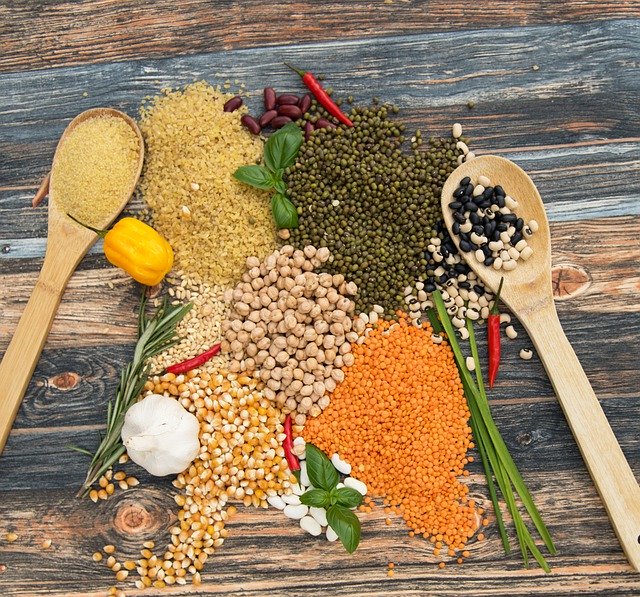
Protein has always been a hot topic of discussion. Who should consume it? How much to consume? And what sources to consider?
Amid this lockdown, where regular gym goers are finding & adjusting to new ways to stay active & fit, they are also exploring more about available sources of protein. The reason for this change is less availability of whey supplements & non-veg which have been top two picks for protein for most of the people before. The focus has shifted more towards vegetarian & dairy sources and combination of these.
Some easily available vegetarian/vegan sources of protein:
1. Lentils (Dal)
Image Source: pixabay.com
Indian kitchens are incomplete without dals, be it arhar, urad or moong (different kinds of lentils). When one is not sure as what to cook, it is usually some dal that shows up. A part of almost every meal, dal is easily available and can be counted on for protein, fiber and essential minerals. Gives you a complete meal when served with a side of rice or roti (Indian Bread).
Protein in lentils (Boiled) – 9 gm per 1/2 cup serving
2. Kidney beans (Rajma)
Image source: pixabay.com
Is rajma crowned as king of Indian kitchen already? If not, shouldn’t it be? A vegetarian/vegan source of protein, carbohydrates and fiber. Rajma is best coupled with boiled or steamed rice, making it an all-time favourite dish in Indian households. Not just delicious, but it’s a wholesome meal. It can be enjoyed in the form of a curry, as a topping in salads, or even with roti.
Protein in rajma (Boiled) – 7.5 gm per 1/2 cup serving
3. Chickpeas (Channa)
Image source: canva.com
Channa (Chickpeas) are definitely a very decent choice for protein when it comes to vegetarian or vegan diet. Channa get served in many different ways; the most common being with puri (deep-fried bread) which is not a very healthy option, but it also makes a brilliant combination with rice or roti. Or you can just simply toss them into salads and enjoy.
Protein in channa (Boiled) – 7.5 gm per 1/2 cup serving
4. Mixed Seeds
Image source: canva.com
Seeds are very easy to get easy to eat thing. They add crunch and a bit of protein to your meals. Simply choose from sesame, hemp, sunflower, pumpkin or chia seeds – as they’re all high in protein and healthy fats. Other than in salads, you can also add them to raita, cereal or put them in a smoothie.
Protein in seeds – 5-7.3 gm per quarter cup serving
5. Nuts
Image source: canva.com
Nuts are very easily available. When you’re looking for healthy snacks or recipe ingredients to incorporate into a health-conscious diet, nuts are a tasty option that can be beneficial to your overall health as they contain fiber and healthy fats as well. Nuts are a good source of protein for vegetarians or for those who simply want to acquire protein from a source other than meat or dairy.
Protein in Nuts – 15-26 gm per 100gm
Other than these we have an easy access to dairy products which are also a very decent option of protein for people who are vegetarian but not vegan.
Milk & paneer (cottage cheese) gives you 9 gm of protein per 1 cup serving (244ml) and 18 gm of protein per 100 g respectively.
*All these sources do not provide only protein, but also carbohydrates, fats, fibre, minerals and vitamins to some extent. It’s not only the protein we care about or need, but also carbohydrates, fats, vitamins as well as minerals. Neither does a single source provide all amino acids required. And, a common man usually struggles to create a balance among all these macros & micros. There comes the role of a Registered Dieticians who are experts in creating all these balances using the sources you want.
Recommended Intakes of Protein
Protein intake has always been debateable. The quantity required varies for every individual, depending on their physical activity or training, bodyweight, health conditions, etc. Although protein has numerous roles in a human body but one of the main or commonly discussed role is muscle repairing/building. This simply means the more your muscle faces wear & tear during the training, more the amount of protein will be required by your body to recover. For example, if we compare an athlete and a common man, athlete will require a high amount of protein because of more muscle breakdown during his high-intensity trainings and games as compared to a regular office going person.
If we talk about the current situation, we all are in, the physical activity levels have drastically dropped. Even if we are involved in home workouts, the intensities are not that high that used to be in the gym. This drop-in activity levels will directly impact the protein intake.
In general, for a person who has no or very low level of physical activity due to lockdown or otherwise, it is recommended that 10-35 percent of your daily energy intake should come from protein. If you consume 2,000 calories per day, this would work out to be between 200 to 700 calories of protein per day. The recommended daily intakes (RDIs) can also be calculated by a person’s body weight. The Academy of Nutrition and Dietetics recommends that the average individual should consume 0.8 grams of protein per kilogram or 0.35 grams per pound of body weight per day for general health.
If we talk about increasing muscle mass in combination with physical activity, it is recommended that a person that lifts weights or is training regularly should consume in between a range of 1.2-1.7 grams of protein per kilogram of body weight per day, or 0.5 to 0.8 grams per pound of body weight. (Recommended values provided by ACSM, American College of Sports Medicine)
Disclaimer: All the content written is for knowledge or reading purpose, we do not recommend any addition or changes in protein sources or quantity. Consult a Registered Dietician or Qualified Nutritionist before considering any changes.







